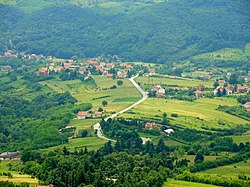Trešnja
|
Ripanj Рипањ |
|
|---|---|
| suburb of Belgrade | |

Ripanj
|
|
| Coordinates: 44°38′N 20°31′E / 44.633°N 20.517°E | |
| Country |
|
| Population (2011) | |
| • Total | 11,018 |
| Time zone | CET (UTC+1) |
| • Summer (DST) | CEST (UTC+2) |
| Area code(s) | 011 |
Ripanj (Serbian Cyrillic: Рипањ) is a suburban settlement of Belgrade, the capital of Serbia. It is located in Belgrade's municipality of Voždovac. It has a distinction of being "the largest village of Serbia" taking in account its number of population, but also because it has the largest area of all rural settlements in the country.
Ripanj is located some 25 kilometers south of Belgrade, on the southern slopes of the Avala mountain, in the valley of the Topčiderka river. It is the southernmost settlement in the municipality, on the northern side of the Lipovica woods, near the tripoint of the municipalities of Voždovac, Barajevo and Sopot.
It is believed that settlement got its name from the large rock in the vicinity, called Ripa. Slopes of the Avala were already inhabioted in Neolithic. The location is an old mining area as it is known that already Romans were extracting mercury and silver and the tradition was later continued by the medieval Saxon miners. One of the major Serbian industrialists in the early 20th century, Đorđe Vajfert, also owned several mining fields. The mercury extraction from the Avala mountain ended in the second half of the 20th century.
The village got its first school in 1824, the same year when the first church was built. The small, wooden church (crkva-brvanara) was later replaced with the large Church of the Holy Trinity in 1892.
Ripanj used to be a separate municipality which originally comprised only the village of Ripanj. It had a population of 7,475 in 1948 and 8,255 in 1953. In 1956, Brđani and Bošnjaci were detached from the settlement of Ripanj into separate settlements, but within the municipality. Ripanj was then annexed to the municipality of Voždovac, but if it had continued to exist it would have a population of 10,533 in 1961 and 10,673 in 1971. Brđani, in 1977, and Bošnjaci, in 1979, were abolished as a separate statistical entities, becoming part of the village of Ripanj again, which,since then corresponds to the area and population of the former municipality.
...
Wikipedia

